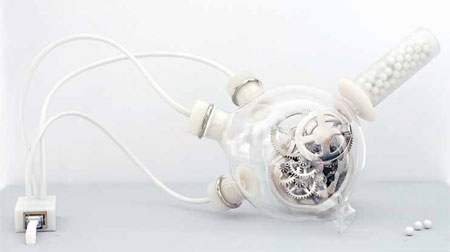Seduced with form, taken into future
Updated: 2013-03-17 08:36
(The New York Times)
|
|||||||
|
The Cohen artificial biological clock and, below left, the honeycomb vase Made by Bees (2006) by Tomas Gabzdil Libertiny; the Andrea Air Purifier (2009) by Mathieu Lehanneur; and the Vander Kooij chair. Photographs Courtesy of The Museum of Modern Art, New York |

'Applied Design," a show of works from the Museum of Modern Art in New York's design collection, is a bold bracketing of furnishings, tools, graphics and games that challenge what we imagine design to be. Unlike the streamlined chairs, automobiles and utensils that are staples of MoMA's collection, most of the roughly 100 items displayed here will never be found on eBay.
But you can see them in video arcades and biotechnology labs and even on the keypads of communications devices.
Organized by Paola Antonelli, senior curator of architecture and design at the museum, "Applied Design" will be on view through January 2014.
"Applied Design" joins objects from earlier shows and recent additions to the permanent collection. The Artificial Biological Clock designed by Revital Cohen, for example, has been shown before. The clock is a prototype for a device that collates online data from a woman's doctor, therapist and banker to determine the right time for her to have a child.
Ms. Antonelli said she was thinking about a future when the design field will be subdivided, like physics, into theoretical and applied branches. At the same time, she said, she was revisiting an old term for design: "applied art."
Fundamentally, however, "Applied Design" refers to the many arenas in which designers are active. Ms. Antonelli hasn't abandoned the object, but she is keen to show it as an outgrowth of open-ended technologies like 3-D printing and conceptual models like biomimicry, where design is patterned on nature.
On view, for example, is the Lily Impeller, a flowing hunk of stainless steel that Jayden D. Harman, an inventor and entrepreneur, modeled on the Fibonacci spiral. The shape, which curls like a nautilus shell, allows the device to circulate millions of liters of water efficiently in municipal water systems.
It's a gorgeous object. "I want to remind people of the importance of elegance: the fact that beauty should not be costlier or harder to find than nonbeauty," Ms. Antonelli said of the many visually compelling displays, including lacy textiles from the Dutch studio Freedom of Creation made by rapid-prototyping technology and a floor lamp by the British designer Paul Cocksedge that is effectively a big fiber-optic strand. People who stop to admire such objects will be poised to think about "a world of very serious manufacturing and materials considerations," she said. "They seduce you with their form, then transport you into the future of design."
And what if those seductions lead not to the future but to a dead end of artistic self-indulgence? The kind of object that looks better on paper (or in a museum setting) than in practice?
That's the charge against one of the star exhibits, Mine Kafon, an instrument designed to float across fields and detonate buried land mines. Created by Massoud Hassani, an Afghan, as a student project at Design Academy Eindhoven in the Netherlands, Mine Kafon would seem above reproach: it's made inexpensively of recycled materials; it's powered by a renewable energy source, the wind; it promises to save lives; it can be easily repaired when damaged; and with its resemblance to a fluffy dandelion, it's a visual poem. Sitting in the corner of an exhibition space, it commands serious attention.
But Marc Vlemmings, a journalist in the Netherlands, is a critic of the invention. Debating its merits in the Dutch design magazine Items, he argued that Mine Kafon is a prototype that hasn't been tested and refined sufficiently to earn its plaudits. He was rankled by the premise of a minesweeper following an erratic, wind-driven path rather than a systematic program for clearing the weapons. "The Mine Kafon provides inhabitants of a mine-infested area with a false sense of security," he said.
When told of the objection, Ms. Antonelli countered: "Sometimes there are hero objects that sensitize the world. I never thought that it was tested and ready to be deployed, but I thought that the concept was so strong, so convincing and so powerful, even because of the connection to the designer's personal history, that it was enough for us."
Still, the idea of heroic yet possibly ineffective design would have disturbed some of Ms. Antonelli's predecessors at MoMA. Much modern design is based on the principle that objects that perform wonderfully (whether paper clips or BMWs) can't help looking wonderful, whereas objects that fail to work bear the aesthetic mark of their ineptitude. History has proved this maxim wrong many times, but never so persuasively as in the age of the computer chip, when the relationship between appearance and performance has become increasingly irrelevant.
Ms. Antonelli is calling a messy, restless, enthralling discipline exactly as she sees it. Maybe it's time to think of another name for design - or several.
The New York Times

(China Daily 03/17/2013 page9)
